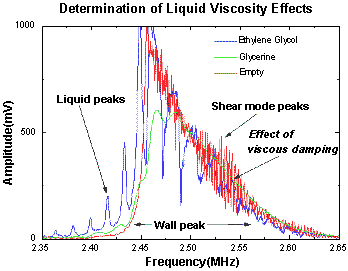New Analytical Method Helps Verify Chemical Weapons Compliance - Page 2

Figure 2. A superimposed spectrum showing various aspects of SFAI. This spectrum shows a combination of the liquid peaks, container wall peak, and interference peaks from circumferential modes that are damped by the viscous coupling of the liquid
Information about the contents is derived from an analysis of the spectrum of resonance peaks. A single sweep measurement can be used to derive liquid properties that include sound speed, sound absorption, frequency dependence of sound absorption, and liquid density. Sound speed is determined from the spacing of the peaks. In a noninvasive measurement, sound waves inside the container are attenuated because of the absorption of the sound, which is frequency-dependent, and also due to the acoustic impedance mismatch between the container wall and the liquid inside. Sound attenuation at a given frequency is determined by the width of the resonance peak. Density is determined from measurements of peak width over a wide band of frequencies followed by extrapolating the peak width to zero frequency, giving the value of the acoustic impedance ratio of the wall to the material. Viscosity is determined from the interference of sound waves that go around the circumference of the container and appear superimposed on top of the liquid spectrum. In SFAI, deriving so much information from the one measurement is important, particularly in the area of chemical diagnostics. Many chemical compounds can have the same sound speed, for example, but none is identical across all four parameters.
In the development of the SFAI process, the task for researchers was to create algorithms that would derive sound velocity, attenuation, density, and viscosity from the spectrum. To do this, literally thousands of data sets from tests were plotted against theoretical predictions. Each new data set had many subtle variations some of which hid patterns that could be used to determine the properties of the fluid inside the sealed container. Data analysis software, Origin from OriginLab Corporation (formerly Microcal Software Inc.), Northampton, Massachusetts, was selected to analyze the data because it provided all the advanced data analysis routines required to detect underlying patterns. In addition, its ability to easily visualize data turned out to be critical to this work.
1 2 3